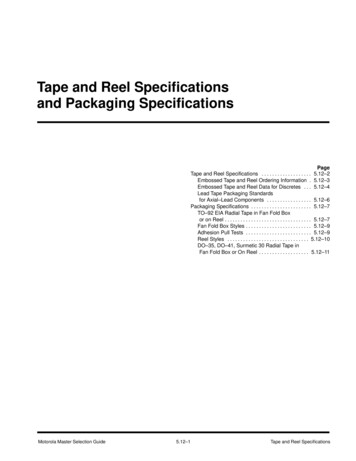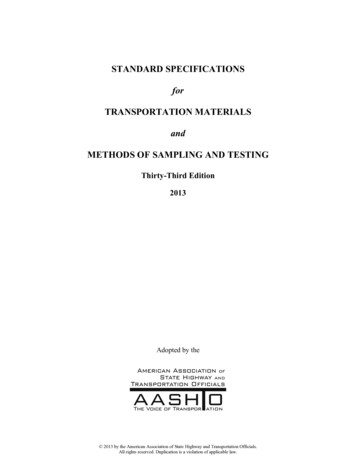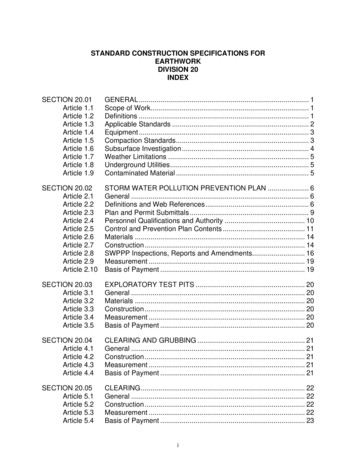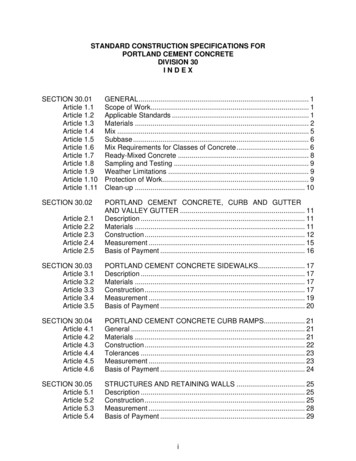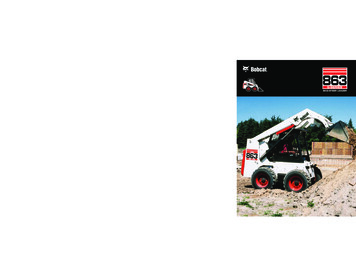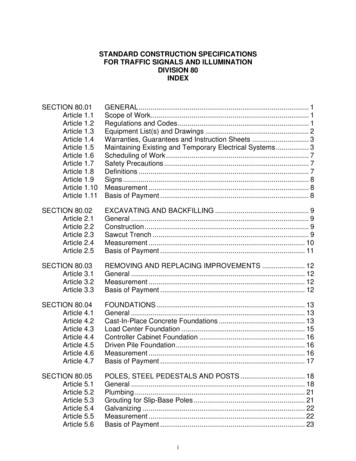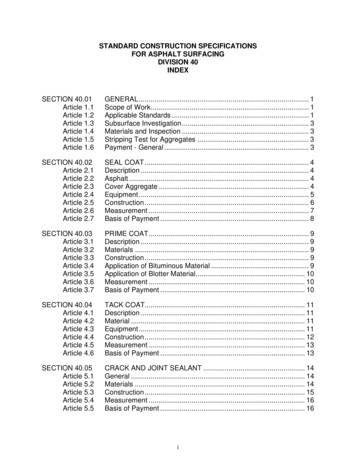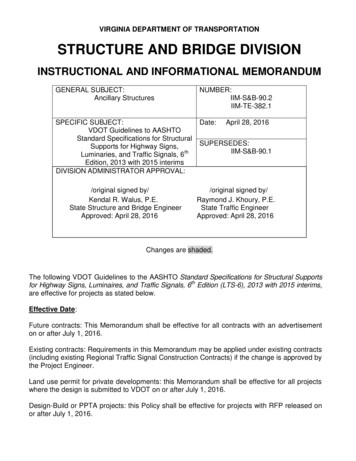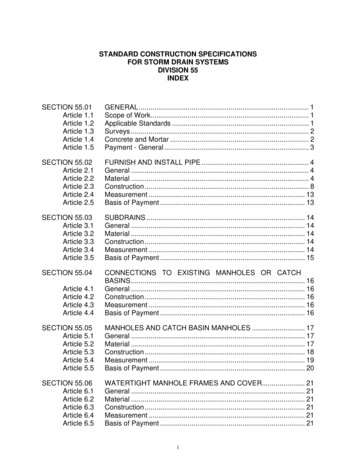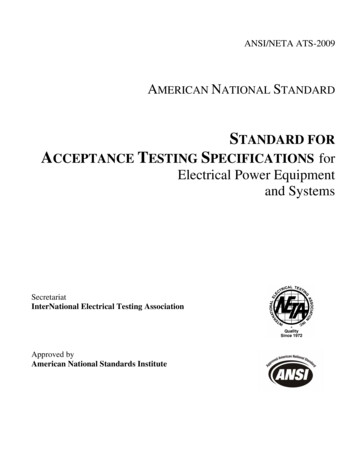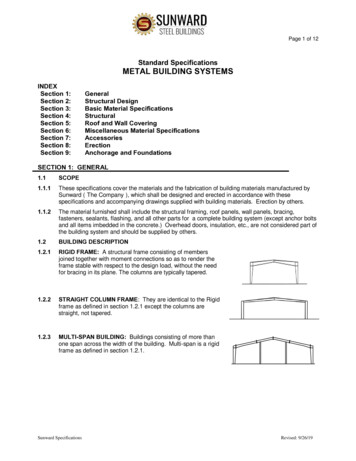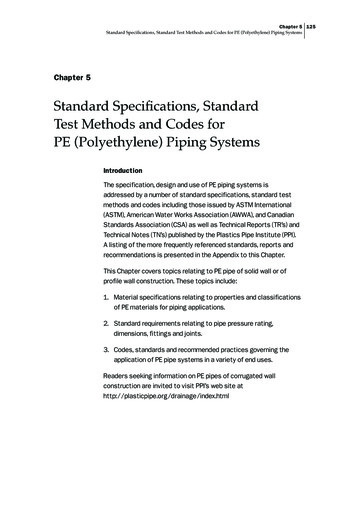
Transcription
Chapter 5 125Standard Specifications, Standard Test Methods and Codes for PE (Polyethylene) Piping SystemsChapter 5Standard Specifications, StandardTest Methods and Codes forPE (Polyethylene) Piping SystemsIntroductionThe specification, design and use of PE piping systems isaddressed by a number of standard specifications, standard testmethods and codes including those issued by ASTM International(ASTM), American Water Works Association (AWWA), and CanadianStandards Association (CSA) as well as Technical Reports (TR’s) andTechnical Notes (TN’s) published by the Plastics Pipe Institute (PPI).A listing of the more frequently referenced standards, reports andrecommendations is presented in the Appendix to this Chapter.This Chapter covers topics relating to PE pipe of solid wall or ofprofile wall construction. These topics include:1. Material specifications relating to properties and classificationsof PE materials for piping applications.2. Standard requirements relating to pipe pressure rating,dimensions, fittings and joints.3. Codes, standards and recommended practices governing theapplication of PE pipe systems in a variety of end uses.Readers seeking information on PE pipes of corrugated wallconstruction are invited to visit PPI’s web site 3.indd 1251/16/09 9:53:16 AM
126 Chapter 5Standard Specifications, Standard Test Methods and Codes for PE (Polyethylene) Piping SystemsStandard Requirements for PE Piping MaterialsAs discussed in Chapter 3, polyethylene (PE) is a complex polymer with propertiesthat can be optimized based on the desired end use. Such modifications are effected bychoice of catalyst system, polymerization conditions and, the use of a small quantity ofco-monomer ( a monomer or monomers other than ethylene). All these changes allowPE to be tailor made to a wide range of processing and performance requirements.For classifying this wide array of property variations that find use in pipingapplications, ASTM issued standard D 3350, “Standard Specification for PolyethylenePlastic Pipe and Fittings Materials”. This standard recognizes six properties that areconsidered important in the manufacture of PE piping, in the heat fusion joining ofthis material and, in defining its long-term performance capabilities. Each property isassigned into a “Cell” and, each cell consists of a number of “Classes”. A cell numbercovers a narrow range of the larger overall range that is covered by a property “cell”.These D 3350 property cells and classes are identified in Table 1.124-153.indd 1261/16/09 9:53:16 AM
Chapter 5 127Standard Specifications, Standard Test Methods and Codes for PE (Polyethylene) Piping SystemsTABLE 1Cell Classification System from ASTM D 3350-06 1,2PropertyTestMethod012345Density, g/cm3 D 1505unspecified0.925 orlower 0.925 0.940 0.940 0.947 0.947 0.955 0.955Melt Indexunspecified 1.01.0 to 0.4 0.4 to0.15 0.15AD lexuralModulus,MPa (psi), 2%secantD 790unspecified 138( 20,000)758138- 276 276- 552 552- 758 1103 1103specify(20,000 to (40,000 to (80,000 to (110,000( 160,000) value 40,000) 80,000) 110,000) to 160,000)Tensilestrength atyield, MPa(psi)D638unspecified 15( 2000)15- 18(2200 2600)18- 21(2600 3000)21- 24(3000 3500)24- 28(3500 4000) 28( ��——8(1160)10(1450)—Slow CrackGrowthResistanceI. ESCRD1693unspecifieda. Test conditionb. Test duration, hoursc. Failure, max. %Slow CrackGrowthResistanceF 1473II. PENT(hours)MoldedPlaque, 80 C,2.4MPa,notch depthTable 1unspecifiedHydrostaticStrengthClassificationI. Hydrostatic D2837design basis,MPa, (psi),(23 C)NPRBHydrostaticStrengthClassificationII. MinimumRequiredStrength,MPa (psi),(20 C)—ISO12162—specifyvalue—Notes to Table 1-A: Refer to 10.1.4.1 (ASTM D 3350) B: NPR Not Pressure Rated, 1.) D 3350 is subject toperiodic revisions, contact ASTM to obtain the latest version, 2.) The property and density are measured onthe PE base resin; all the other property values are measured on the final compound.In addition, by means of a Code letter, ASTM D3350 designates whether the materialincludes a colorant and also, the nature of the stabilizer that is included for protectingthe material against the potential damaging effects of the ultraviolet (UV) rays insunlight. Table 2 lists the Code letters that are used in D 3350 and what they reprsent.124-153.indd 1271/16/09 9:53:16 AM
128 Chapter 5Standard Specifications, Standard Test Methods and Codes for PE (Polyethylene) Piping SystemsTABLE 2Code Letter RepresentationCode LetterColor and UV StabilizerANaturalBColoredCBlack with 2% minimum carbon blackDNatural with UV stabilizerEColored with UV stabilizerFor designating a PE material in accordance with ASTM D 3350 the cell numberfor each cell property is identified, and this is done in the same order as shown inTable 1. This is then followed by an appropriate Code letter to indicate color andstabilization as shown in Table 2. An example of this material designation system ispresented in Table 3 for the case of a PE material having designation code PE445574C.Table 3Properties of a Cell number PE445574 MaterialDigit Designating the Applicable Property Cell (1)ClassNumber orCode LetterCorresponding Value of Property(from Table1)1st Digit – Density of PE base resin, gm/cm34 0.947 – 0.9552nd Digit – Melt Index of compound,gm/10 minutes4 0.153rd Digit – Flexural Modulus of compound,psi (MPa)5110,000 - 160,000 (758 - 1103)4th Digit – Tensile Strength at Yieldof compound, psi (MPa)53,500 - 4,000 (24 - 28)5th Digit – Resistance to Slow Crack Growthof compound (SCG), hrs.7500 minimum based on PENT test6th Digit – Hydrostatic Design Basis for water at73 F (23 C), psi of compound (MPa)41600 (11.03)Code LetterCBlack with 2% minimum carbon black(1) The density is that of the PE resin. All the other properties are determined on the final compounded material.A PE material that complies with the Table 3 cell designation i.e. PE445574C wouldbe a higher density (higher crystallinity), lower melt index (higher molecular weight)material that exhibits exceptionally high resistance to slow crack growth. In addition,it offers a hydrostatic design basis (HDB) for water at 73 F (23 C) of 1600 psi (11.03MPa). Finally, it would be black and contain a minimum of 2% carbon black.The cell classification system provides the design engineer with a very useful tool inspecifying the requirements of PE materials for piping projects.124-153.indd 1281/16/09 9:53:16 AM
Chapter 5 129Standard Specifications, Standard Test Methods and Codes for PE (Polyethylene) Piping SystemsStandard PE Piping Material Designation CodeWhile all PE piping standards specify minimum material requirements based theon the cell requirements of ASTM D3350, a simpler, short-hand, ASTM recognizedmaterial designation code is commonly used for quickly identifying the mostsignificant engineering properties of a PE pipe material. An important feature ofthis designation code is that it identifies the maximum recommended hydrostaticdesign stress (HDS) for water, at 73 F(23 C). Originally, this designation code wasdevised to only apply to materials intended for pressure piping. However, there isa recognition that even in non-pressure applications stresses are generated whichmakes it prudent to use a stress rated material. This has led to the common practice ofusing this material designation code for quickly identifying all PE piping materialsintended for pipes of solid wall or, of profile wall construction.This code is defined in ASTM F412, “Standard Terminology Relating to Plastic PipingSystems”, under the definition for the term code, thermoplastic pipe materialsdesignation. It consists of the ASTM approved abbreviation for the pipe materialfollowed by four digits (e.g., PE4710). The information delivered by this code is asfollows: The ASTM recognized abbreviation for the piping material. PE, in the case ofpolyethylene materials. The first digit identifies the density range of the base PE resin, in accordance withASTM D3350, that is used in the material. As discussed in Chapter 3, the densityof a PE polymer reflects the polymer’s crystallinity which, in turn, is the principaldeterminant of the final material’s strength and stiffness properties. The second digit identifies the compound’s resistance to slow crack growth (SCG),also in accordance with ASTM D3350. A material’s resistance to SCG relates verystrongly to its long-term ductility, a property that defines the material’s capacity forsafely resisting the effects of localized stress intensifications. The last two numbers identify the compound’s maximum recommendedhydrostatic design stress (HDS) category (1) for water, at 73 F(23 C). Thisrecommendation is established in consideration of various factors but, primarilythe following: The capacity for safely resisting the relatively well distributedstresses that are generated only by internal pressure, and, the capacity for safelyresisting add-on effects caused by localized stress intensifications.(1)(1) More discussion on these topics later in this Chapter.The Standard Designation Codes for materials which are recognized as of thiswriting by current ASTM, AWWA, CSA and other standards are listed in Table 4.This table gives a brief explanation of the significance of the code digits. It should124-153.indd 1291/16/09 9:53:16 AM
130Chapter 5Standard Specifications, Standard Test Methods and Codes for PE (Polyethylene) Piping Systemsbe recognized that a new material may be commercialized which qualifies for a codedesignation that has not been recognized as of this writing. For a listing of the mostcurrent recognized code designations the reader is invited to consult the periodicallyupdated PPI publication TR-4. Contact PPI via their website, www.plasticpipe.orgTABLE 4Standard Designation Codes for Current Commercially Available PE Piping CompositionsWhat the Digits in the Code DenoteStandard DesignationCodePE2406PE2708The 1st DigitCell Number Based on the Cell Number Based on theDensity Cell In accordanceResistance to SCG Cellwith ASTM D3350In accordance with ASTM(See Table 1)D3350 (2) (See Table 1)Cell number 2PE3408PE3608PE3708PE4710The last two Digits(1)Recommended StandardHydrostatic Design Stress(HDS) Category, for water,at 73 F (23 C) (psi)Cell number 4630Cell number 7800Cell number 4Cell number 3Cell number 6Cell number 7PE3710PE4708The 2nd DigitCell number 4Cell number 78008001,0008001,000(1) The last two digits code the Standard HDS Category in units of 100psi. For example, 06 is the code for 630psiand 10 is the code for 1,000psi.(2) It should be noted that the lowest Cell number for SCG resistance for pipe is 4. Based on research andexperience a rating of at least 4 has been determined as sufficient for the safe absorption of localized stressesfor properly installed PE pipe.Standard Equation for Determining the Major Stress Induced in aPressurized PipeThere are two major stresses which are induced in the wall of a closed cylindricalvessel, such as a pipe, when it is subjected to internal fluid pressure. One runs alongthe axis of the vessel, often called the axial (longitudinal) stress, and the other, whichis often called the hoop stress, runs along its circumference. Since the magnitude ofthe hoop stress is about twice that of the axial stress the hoop stress is considered asthe significant stress for purposes of pressure pipe design.The hoop stress is not constant across a pipe’s wall thickness. It tends to be larger onthe inside than on the outside of a pipe. And, this tendency is heightened in the caseof materials having high stiffness and in thicker walled pipes. However, in the case ofpipes made from thermoplastics – materials which are characterized by significantlylower stiffness than metals – it has long been accepted that the hoop stress is constantthrough the pipe’s wall thickness. For such case the so called thin-walled hoop stressequation is accepted as satisfactory and it has been adopted by standards which124-153.indd 1301/16/09 9:53:16 AM
Chapter 5 131Standard Specifications, Standard Test Methods and Codes for PE (Polyethylene) Piping Systemscover thermoplastics pipe. This equation, which more commonly is identified as theISO (International Organization for Standardization) equation because it has beenalso adopted for thermoplastic pipes by that organization, is as follows:(1)WhereS Hoop stress (psi or, MPa)P Internal pressure (psi or, MPa)Dm Mean diameter (in or, mm)t minimum wall thickness, (in or, mm)Because PE pipe is made either to controlled outside diameters or in some cases, tocontrolled inside diameters the above equation appears in PE pipe standards in oneof the following forms:When the pipe is made to a controlled outside diameter:(2)Where Do is the average outside diameterWhen the pipe is made to a controlled inside diameter:(3)Where Di is the average inside diameterFor purposes of pressure pipe design, the pipe’s pressure rating (PR) is determinedby the hydrostatic design stress (HDS) that is assigned to the material from which thepipe is made. Therefore, Equation (2) can be re-arranged and written in terms of HDSand as follows:(4)Where PR is the pressure rating (psi or, MPa) and HDS is the hydrostatic design stress (psi or, MPa)And, Equation (3) becomes:(5)124-153.indd 1311/16/09 9:53:16 AM
132 Chapter 5Standard Specifications, Standard Test Methods and Codes for PE (Polyethylene) Piping SystemsThe term Do/t is referred to as the outside diameter dimension ratio and the term Di/tas the inside diameter dimension ratio. However, the convention in PE pipe standards isto limit these ratios to a standard few. The ASTM terms and abbreviations for thesepreferences are: Standard Dimension Ratio (SDR), for a standard Do/t dimension ratio Standard Inside Diameter Ratio (SIDR), for
applications, ASTM issued standard D 3350, “Standard Specification for Polyethylene Plastic Pipe and Fittings Materials”. This standard recognizes six properties that are considered important in the manufacture of PE piping, in the heat fusion joining of this material and, in defining its long-term performance capabilities. Each property is assigned into a “Cell” and, each cell consist
